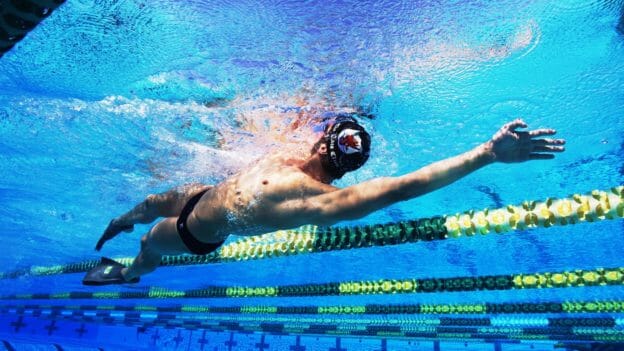The fundamentals of backstroke are the same as for freestyle. However, the priority of those fundamentals differ for backstroke and there are certain nuances of backstroke that differ from freestyle.
Of all four strokes, backstroke is not the fastest stroke, but it is the most efficient stroke. That means that there is less change of speed in backstroke than in any other stroke. There are two principal reasons for that. First, the coupling of the body rotation comes at the very end of the pulling motion, which is the weaker part of the pull, as opposed to the stronger middle of the pull in freestyle. The result is the propulsive force of the arm pull remains more constant in backstroke.
The second reason that the velocity of the backstroker is more uniform has to do with the kick. When a swimmer is on his or her stomach, the down kick is typically much more propulsive than the up kick. However, when on the back, the weaker down kick becomes very propulsive because the foot pushes down against a larger vortex and gravity helps assist in the downward motion of the foot. As a result, the propulsive forces of the down and up kicks become much more even and the resultant velocity is more constant.
When it comes to taking advantage of these two nuances of backstroke, here are two important pearls in your technique that will help.
- On the backstroke arm recovery, throw the arm and hand hard to the water. Accentuating the speed of the hand entry on the recovery also has the effect of accentuating the body rotation. This will help maintain the swimmer’s speed toward the end of the pulling motion.
- Work the down kick hard on backstroke. During both the underwater dolphin kick and the backstroke, it is very important to press downward vigorously with the sole or bottom of the foot to take advantage of the large vortex formed from the stronger up kick. If a swimmer does this, he or she can get more propulsion and speed from the weaker down kick than from the stronger up kick. This downward motion of the feet will also help keep the swimmer’s speed more constant.
This week our Race Club members in Lane 2 will get classroom instruction on how the fundamentals of backstroke differ from those of freestyle. Race Club members in lane 3 will see a great dryland technique from world champion Junya Koga on how to teach swimmers the proper backstroke pulling motion. You can hop in one of our Race Club lanes here.
Yours in Swimming,
Gary Sr.

